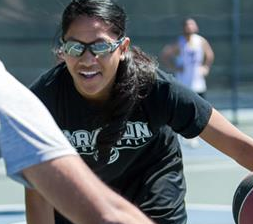New research shows that about 30,000 people in the U.S. go to emergency departments each year with sports-related eye injuries, a substantially higher estimate than previously reported.
This April during Sports Eye Safety Month, the Kentucky Academy of Eye Physicians and Surgeons and the American Academy of Ophthalmology remind the public that the right protective eyewear is the best defense against eye injury.
Three sports accounted for almost half of all trips to the emergency room: basketball, baseball and air/paintball guns. Sports-related injuries can range from corneal abrasions and bruises on the lids to more serious, vision-threatening internal injuries, such as a retinal detachment and internal bleeding.
Ophthalmologists — physicians who specialize in medical and surgical eye care — continue to remind the public that most sports-related eye injuries are avoidable.
Here are some tips for both the professional athlete and the Little League star to stay safe:

• Parents should make sure that children wear eye protection. Most often, those who sustain sports-related eye injuries are 18 years old or younger.
• Eye protection can weaken with age and may no longer provide adequate protection. Consider replacing when damaged or yellowed.
• For basketball, racquet sports, soccer and field hockey, wear protective eyewear with polycarbonate lenses.
• Athletes who wear contacts or glasses should also wear appropriate protective eyewear. Contacts offer no protection and glasses do not provide enough defense.
• Professional athletes should also wear sports goggles that meet national standards.
“I’ve treated many patients with eye trauma because of an unintentional blow to the face,” said Rahul N. Khurana, M.D., clinical spokesperson for the American Academy of Ophthalmology. “Athletes often engage in these seemingly safe, yet rugged, high-impact sports with zero awareness about the potential risk factors. This is why eye protection is critical and can greatly reduce the number of emergency room visits treated each year.”

“Each year we see a peak in sports-related eye injuries with the start of baseball and basketball season,” said Christopher Compton, M.D., Assistant Professor of Oculofacial Plastic and Orbital Surgery at the University of Louisville. “Eye injuries and orbital fractures are extremely common (resulting in more than 42,000 emergency room visits last year, with 13,500 resulting in permanent vision loss).
“According to the National Eye Institute, 90 percent of these injuries could be prevented with protective eyewear. Despite these startling numbers, most leagues do not mandate eye protection and parents must therefore insist that their children wear protective eyewear.”
For more information on sports-related eye injuries or other eye conditions and diseases, visit the American Academy of Ophthalmology’s EyeSmart website.
From Kentucky Academy of Eye Physicians and Surgeons
















